Here it is: on Tuesday, April 24, I caught a 7 a.m. flight to Vienna to begin a five-day journey across Austria, a country I’ve long dreamed of visiting.
From the moment my trip began, one thought popped into my mind about Austria, and it remained the recurring theme throughout my trip: civilized.
 Yes, there is no doubt that the Austrians are civilized, and it comes out in everything they do, including how they run their airline. I flew Austrian Air from Florence to Vienna, a flight that takes about two-and-a-half hours, including an odd short stop in Bologna to pick up additional passengers.
Yes, there is no doubt that the Austrians are civilized, and it comes out in everything they do, including how they run their airline. I flew Austrian Air from Florence to Vienna, a flight that takes about two-and-a-half hours, including an odd short stop in Bologna to pick up additional passengers.As soon as I boarded the plane, I noticed strains of classical music coming out through the speaker system. And when I sat down, I immediately noticed how comfortable my seat was, with plenty of leg room, even for a much taller person! As soon as we all boarded, the flight attendant came down the aisle wheeling a rack filled with newspapers in different languages, and I helped myself to an International Times Herald. I felt as if I were in first class! On top of all this, we actually got food on the flight, even though it was so short, and decent food at that, including fresh fruit and warm freshly baked rolls. I plan to fly Austrian Air every chance I get!
 We landed in Vienna at 9:20 a.m., right on time; of course, I didn’t expect anything less! I then took the train from the airport into the city and walked to my hotel, the Hotel Savoy, very close to the Museum Quarter. My room wasn’t quite ready, so the man at the desk suggested that I get a coffee in a cute pedestrian-only neighborhood right down the street known as the Spittleberg Quarter, a real slice of Old Vienna with cobblestone streets lined with Baroque-style homes. A wonderful introduction to Vienna!
We landed in Vienna at 9:20 a.m., right on time; of course, I didn’t expect anything less! I then took the train from the airport into the city and walked to my hotel, the Hotel Savoy, very close to the Museum Quarter. My room wasn’t quite ready, so the man at the desk suggested that I get a coffee in a cute pedestrian-only neighborhood right down the street known as the Spittleberg Quarter, a real slice of Old Vienna with cobblestone streets lined with Baroque-style homes. A wonderful introduction to Vienna!I found a coffee shop and ordered a cappuccino, and when it was served to me, there was that civilized thing again. You see, this wasn’t a fancy coffee shop, just a small corner café. Yet my cappuccino was served in a beautiful china cup on a silver tray with a small glass of water beside it. Impressive! And it cost me all of 1 euro!

 After enjoying my morning coffee, I went back to my hotel, and my room was ready, just as promised. The room itself was nice, although I must admit that the view left a little to be desired (I don't know, constructions sites have never really been my thing--more on that later)!
After enjoying my morning coffee, I went back to my hotel, and my room was ready, just as promised. The room itself was nice, although I must admit that the view left a little to be desired (I don't know, constructions sites have never really been my thing--more on that later)!


 I was now ready to start exploring Vienna. Now, here I was in one of the world’s great cities, with the Kunsthistorisches Museum, what some consider to be one of the most important museums in the world, just a few blocks away, not to mention many other famous attractions. So what’s the first thing I did? Well, I headed to the Prater Amusement Park, across the Danube Canal, to ride the giant Ferris wheel, of course!
I was now ready to start exploring Vienna. Now, here I was in one of the world’s great cities, with the Kunsthistorisches Museum, what some consider to be one of the most important museums in the world, just a few blocks away, not to mention many other famous attractions. So what’s the first thing I did? Well, I headed to the Prater Amusement Park, across the Danube Canal, to ride the giant Ferris wheel, of course!
 The amusement park on this site dates back to 1766 when Emperor Joseph II declared that the land known as the Prater would be open to the public. It really is a step back in time, although not quite that far back. Most of the surviving rides along the 3-mile promenade date back no later than the 1920s and 1930s. That’s because much of the park was destroyed by fire during World War II in 1945.
The amusement park on this site dates back to 1766 when Emperor Joseph II declared that the land known as the Prater would be open to the public. It really is a step back in time, although not quite that far back. Most of the surviving rides along the 3-mile promenade date back no later than the 1920s and 1930s. That’s because much of the park was destroyed by fire during World War II in 1945.

 The most famous ride of all, and one that survived the fire, although it was badly damaged during the war, is the Riesenrad, a giant Ferris wheel that stands 200 feet. Now this is no thrill ride; rather, it’s a nice leisurely ride in large cars that allow expansive views of Vienna. But that’s not why I wanted to ride this Ferris wheel so badly. No, I wanted to ride it because I’m a film noir buff, and this is the very Ferris wheel that Orson Wells rode near the end of the classic 1949 film noir The Third Man, based on a novel by Graham Greene and set in post-war Vienna. In addition to its film notoriety, this Ferris wheel was one of only three built in Europe in the late 1800s, and it’s the only one that hasn’t since been dismantled. And to top that, it’s still fully functional!
The most famous ride of all, and one that survived the fire, although it was badly damaged during the war, is the Riesenrad, a giant Ferris wheel that stands 200 feet. Now this is no thrill ride; rather, it’s a nice leisurely ride in large cars that allow expansive views of Vienna. But that’s not why I wanted to ride this Ferris wheel so badly. No, I wanted to ride it because I’m a film noir buff, and this is the very Ferris wheel that Orson Wells rode near the end of the classic 1949 film noir The Third Man, based on a novel by Graham Greene and set in post-war Vienna. In addition to its film notoriety, this Ferris wheel was one of only three built in Europe in the late 1800s, and it’s the only one that hasn’t since been dismantled. And to top that, it’s still fully functional! I couldn’t wait to ride it myself! So I boarded Car No. 2, along with four other people, and up we went! The views were indeed spectacular, not only of Vienna but also of Prater itself. And on the way down I noticed that Car No. 30 was made up for a special wedding dinner. Imagine doing that!
I couldn’t wait to ride it myself! So I boarded Car No. 2, along with four other people, and up we went! The views were indeed spectacular, not only of Vienna but also of Prater itself. And on the way down I noticed that Car No. 30 was made up for a special wedding dinner. Imagine doing that!
After riding the Ferris wheel, I toured the Prater Museum, which had many displays documenting the long history of the park, including a fairly disturbing display of photos of the “freaks.” I wonder if they do that any more at amusement parks.



 Well, my trip to the park gave me an appetite, and it was definitely time for lunch. So I took the train back to downtown Vienna. I knew exactly where I was going: Griechenbeisl (Greek’s Tavern), located on the Fleischmarkt (Meat Market) street, one of the oldest in the city. This restaurant has been operating in this same location since 1447. Incredible! There’s a wooden sign at the front of the restaurant commemorating a man named Max
Well, my trip to the park gave me an appetite, and it was definitely time for lunch. So I took the train back to downtown Vienna. I knew exactly where I was going: Griechenbeisl (Greek’s Tavern), located on the Fleischmarkt (Meat Market) street, one of the oldest in the city. This restaurant has been operating in this same location since 1447. Incredible! There’s a wooden sign at the front of the restaurant commemorating a man named Max  Augustin, a musician who performed at this restaurant during the plague of 1679. Legend has it that Max somehow managed to fall into a pit filled with plague victims, spent the night there, and was rescued the next morning, fully intact and healthy. Those who knew him well say that he managed to not contract the plague because his bloodstream was so full of alcohol that it could fight off anything. You gotta love old Max!
Augustin, a musician who performed at this restaurant during the plague of 1679. Legend has it that Max somehow managed to fall into a pit filled with plague victims, spent the night there, and was rescued the next morning, fully intact and healthy. Those who knew him well say that he managed to not contract the plague because his bloodstream was so full of alcohol that it could fight off anything. You gotta love old Max! And what a wonderful place the Griechenbeisl was for lunch! The tavern is divided up into numerous rooms, each with its own name and distinct character. I dined in the Zitherstüberln room, at the actual table where during the evening the zither player sits to entertain guests. (Thank goodness they didn’t ask me to fill in for him during lunch!)
And what a wonderful place the Griechenbeisl was for lunch! The tavern is divided up into numerous rooms, each with its own name and distinct character. I dined in the Zitherstüberln room, at the actual table where during the evening the zither player sits to entertain guests. (Thank goodness they didn’t ask me to fill in for him during lunch!)I had the most delicious meal. I started with a bowl of cream leek soup served with a fried quail egg.
 My entrée was beef carpaccio (Mom, you don't want to know!) with leek pesto and pecorino. Divine! At the end of the meal, my waiter asked if I wanted dessert. Although I ordered a caffé macchiato, I declined dessert. Imagine my surprise when the waiter returned and placed a plate down in front of me, saying, “I cannot let you go without having something sweet at all.” And sweet it was! The dessert he gave me was their famous Apricot Dumplings: apricot ice cream in a dumpling with raspberry drizzle and a side of fresh whipped cream. Heaven!
My entrée was beef carpaccio (Mom, you don't want to know!) with leek pesto and pecorino. Divine! At the end of the meal, my waiter asked if I wanted dessert. Although I ordered a caffé macchiato, I declined dessert. Imagine my surprise when the waiter returned and placed a plate down in front of me, saying, “I cannot let you go without having something sweet at all.” And sweet it was! The dessert he gave me was their famous Apricot Dumplings: apricot ice cream in a dumpling with raspberry drizzle and a side of fresh whipped cream. Heaven!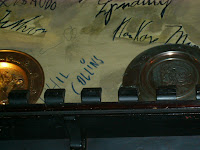


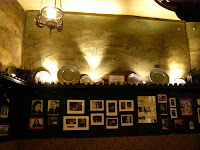 After enjoying this unexpected treat, I asked my waiter where the Mark Twain room was located. He called the busboy over immediately and said, “Please show this lady the Mark Twain room.” This is the room I had been dying to see. Over the years the Griechenbeisl has attracted many famous patrons, and somewhere along the line it became tradition to sign their names on the ceiling of this room. All of these signatures have been beautiful preserved, and the busboy pointed out some of the more famous ones: Mark Twain, Beethoven, Pavarotti, Mozart, and, yes, even Johnny Cash. I also spotted Phil Collins’s signature, which proves that this tradition is alive and well today.
After enjoying this unexpected treat, I asked my waiter where the Mark Twain room was located. He called the busboy over immediately and said, “Please show this lady the Mark Twain room.” This is the room I had been dying to see. Over the years the Griechenbeisl has attracted many famous patrons, and somewhere along the line it became tradition to sign their names on the ceiling of this room. All of these signatures have been beautiful preserved, and the busboy pointed out some of the more famous ones: Mark Twain, Beethoven, Pavarotti, Mozart, and, yes, even Johnny Cash. I also spotted Phil Collins’s signature, which proves that this tradition is alive and well today.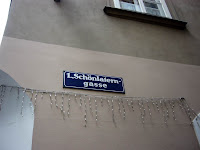





 I hated to leave this special place, but it was time to continue my explorations. Upon exiting the tavern, I headed to Schönlaterngasse (Street of the Beautiful Lantern). (Don’t you just love that name?) This picturesque street was once the heart of Vienna’s medieval Latin Quarter and was named for the wrought-iron lantern that hangs at No. 6. But the most famous home on this street is No. 7. The home located here was built for a baker. Legend has it that on June 26, 1212, a foul-smelling creature (half rooster, half toad) decided to make its home in the courtyard well. In addition to smelling bad, it could also kill you just by glancing at you, and it poisoned the water in the well. Definitely not something you’d want as a housemate! So how do you get rid of such a creature? Well, an apprentice to the baker decided to climb down the well (a brave lad!) with a mirror. The idea was that when the creature saw its own reflection, it would turn to stone. And it evidently worked! The petrified creature is now proudly displayed in a niche on the upper level of the house, along with frescoes telling the tale. And what a tale it is!
I hated to leave this special place, but it was time to continue my explorations. Upon exiting the tavern, I headed to Schönlaterngasse (Street of the Beautiful Lantern). (Don’t you just love that name?) This picturesque street was once the heart of Vienna’s medieval Latin Quarter and was named for the wrought-iron lantern that hangs at No. 6. But the most famous home on this street is No. 7. The home located here was built for a baker. Legend has it that on June 26, 1212, a foul-smelling creature (half rooster, half toad) decided to make its home in the courtyard well. In addition to smelling bad, it could also kill you just by glancing at you, and it poisoned the water in the well. Definitely not something you’d want as a housemate! So how do you get rid of such a creature? Well, an apprentice to the baker decided to climb down the well (a brave lad!) with a mirror. The idea was that when the creature saw its own reflection, it would turn to stone. And it evidently worked! The petrified creature is now proudly displayed in a niche on the upper level of the house, along with frescoes telling the tale. And what a tale it is!


 After all this tale-telling, it was time to go to church! So I walked over to Vienna’s most famous church, Stephansdom (St. Stephan’s Church). This is the church that stands at the heart of the city and towers over all of Vienna. The traditional Viennese horse and carriages line up outside the walls of the church, ready to whisk people off for a romantic ride over the cobblestones.
After all this tale-telling, it was time to go to church! So I walked over to Vienna’s most famous church, Stephansdom (St. Stephan’s Church). This is the church that stands at the heart of the city and towers over all of Vienna. The traditional Viennese horse and carriages line up outside the walls of the church, ready to whisk people off for a romantic ride over the cobblestones. The church was first built between 1144-47, and the Viennese people love its lack of symmetry, which is caused by additions being added on over the centuries, with no real plan. That’s why part of the church Gothic, some is Baroque, and some is Romanesque. No matter, somehow it works! And even though the church was badly damaged during World War II, the residents of this city made sure that it was rebuilt from the rubble. They love this church. This is where Mozart was married in 1782, where his funeral was held in 1791, and where he is buried.
The church was first built between 1144-47, and the Viennese people love its lack of symmetry, which is caused by additions being added on over the centuries, with no real plan. That’s why part of the church Gothic, some is Baroque, and some is Romanesque. No matter, somehow it works! And even though the church was badly damaged during World War II, the residents of this city made sure that it was rebuilt from the rubble. They love this church. This is where Mozart was married in 1782, where his funeral was held in 1791, and where he is buried.



 The inside of the church is immense, but I was more intrigued by the outside. That’s why I was happy to discover that there’s an elevator that can take you to the top, so off I went. I have really grown to love the views from rooftops! From here I could see all over Vienna, including that famous Ferris wheel! And I just loved the roof, made of thousands of wooden disks in an array of colors, some forming phoenixes to symbolize how the church rose after the damage during the war. And down below that line of horse and carriages kept moving along. People seem to love this traditional ride!
The inside of the church is immense, but I was more intrigued by the outside. That’s why I was happy to discover that there’s an elevator that can take you to the top, so off I went. I have really grown to love the views from rooftops! From here I could see all over Vienna, including that famous Ferris wheel! And I just loved the roof, made of thousands of wooden disks in an array of colors, some forming phoenixes to symbolize how the church rose after the damage during the war. And down below that line of horse and carriages kept moving along. People seem to love this traditional ride!

 After leaving Stephansdom, I soon discovered another church, Peterskirche (St. Peter’s Church), a Baroque church built between 1702 and 1708 on the site of another church that was said to have been built by Charlemagne in 792. A plaque on the side of the church notes this. The most beautiful thing about this church is its cupola through which a dove appears to be flying to the heavens.
After leaving Stephansdom, I soon discovered another church, Peterskirche (St. Peter’s Church), a Baroque church built between 1702 and 1708 on the site of another church that was said to have been built by Charlemagne in 792. A plaque on the side of the church notes this. The most beautiful thing about this church is its cupola through which a dove appears to be flying to the heavens. As luck would have it, I arrived just in time for a concert! A four-piece orchestra, with a conductor and vocalist, was performing classical music. I took a seat and took in this beautiful concert. Another unexpected and delightful surprise in Vienna!
As luck would have it, I arrived just in time for a concert! A four-piece orchestra, with a conductor and vocalist, was performing classical music. I took a seat and took in this beautiful concert. Another unexpected and delightful surprise in Vienna!


 After
After  the concert, I headed over to the Uhrenmuseum (Clock Museum). This museum is located in the top three floors of a beautiful 18th-century home on a cobbled side street. The museum’s collection is made up of over 3,000 timepieces that are arranged chronologically (of course!) from the 15th century to the present. Grandfather clocks, cuckoo clocks, wall clocks, miniature clocks, pocket watches, wrist watches—they were all represented. And I just happened to be there at 4:30, when they all went off in some way. Miraculous! (I would have loved to have been there at noon!)
the concert, I headed over to the Uhrenmuseum (Clock Museum). This museum is located in the top three floors of a beautiful 18th-century home on a cobbled side street. The museum’s collection is made up of over 3,000 timepieces that are arranged chronologically (of course!) from the 15th century to the present. Grandfather clocks, cuckoo clocks, wall clocks, miniature clocks, pocket watches, wrist watches—they were all represented. And I just happened to be there at 4:30, when they all went off in some way. Miraculous! (I would have loved to have been there at noon!)

 Well, my time in Vienna was passing quickly (no pun intended!), and it was time to continue on with The Third Man, and where else would that take me but to the “Third Man Portal.” In the film Orson Welles plays a man named Harry Lime. Joseph Cotton plays Holly Martins, a pulp-fiction writer who comes to Vienna in search of his friend Harry. Harry doesn’t actually appear on film until about an hour into it, where we finally see him in the doorway of his girlfriend’s house at No. 8 Shreyvogelgasse. He was hiding in the dark there, not wanting to be seen, when a light goes on in a window across the way, revealing him to his friend. That’s all I’ll say about the film for now, but you can bet that it will be the first one I watch when I return home!
Well, my time in Vienna was passing quickly (no pun intended!), and it was time to continue on with The Third Man, and where else would that take me but to the “Third Man Portal.” In the film Orson Welles plays a man named Harry Lime. Joseph Cotton plays Holly Martins, a pulp-fiction writer who comes to Vienna in search of his friend Harry. Harry doesn’t actually appear on film until about an hour into it, where we finally see him in the doorway of his girlfriend’s house at No. 8 Shreyvogelgasse. He was hiding in the dark there, not wanting to be seen, when a light goes on in a window across the way, revealing him to his friend. That’s all I’ll say about the film for now, but you can bet that it will be the first one I watch when I return home!
Now, after tracking Harry, it was time to become a part of Vienna’s Café Society! A famous saying goes that there were once more cafés in Vienna than there were banks in Switzerland. Now I’m not sure who actually counted, but many of those famous cafés still exist today. And the Viennese still come to these cafés starting at around 4 p.m. to read, chat, gossip, do business, meet with friends, and maybe, just maybe, even actually have a cup of coffee! My task was to pick the perfect one as this would be my only chance to experience this part of Vienna’s culture. Naturally I chose Café Central, the granddaddy of them all. Many consider this the second-most-famous coffeehouse in the world, right behind Caffé Florian in Venice, which of course you know I also visited if you’ve been keeping up with this blog!
Café Central is where Lev Bronstein, better known as Leon Trotsky, used to play chess. Now this may sound rather dull, but the story goes that Trotsky just happened to map out the entire Russian Revolution right here over some of those chess games! I couldn’t wait to see it for myself, so I pulled out my trusty map and headed that way.


 I found it on Herrengasse, a beautiful café with domed ceilings, marble floors, glass chandeliers, and soft lighting. To make it even better, Frank Sinatra was playing on the sound system. I ordered a Viennese favorite, Kaffee mit Schlag (coffee with whipped cream), delivered to me, of course, on a silver tray with a glass of water and a piece of chocolate. While enjoying my coffee, I pulled out my Fodor’s guide to make sure that I didn’t miss any special that I should see in the café. As I read further, I realized that I wasn’t in the Café Central at all! Rather, I was in an offshoot of the café, a “baby” Café Central if you will, on the same street but not the real thing. Well, at least I found out then!
I found it on Herrengasse, a beautiful café with domed ceilings, marble floors, glass chandeliers, and soft lighting. To make it even better, Frank Sinatra was playing on the sound system. I ordered a Viennese favorite, Kaffee mit Schlag (coffee with whipped cream), delivered to me, of course, on a silver tray with a glass of water and a piece of chocolate. While enjoying my coffee, I pulled out my Fodor’s guide to make sure that I didn’t miss any special that I should see in the café. As I read further, I realized that I wasn’t in the Café Central at all! Rather, I was in an offshoot of the café, a “baby” Café Central if you will, on the same street but not the real thing. Well, at least I found out then!

 I still thoroughly enjoyed my coffee, paid my bill, and set off in search of the real thing. It turned out that the café was located just across the street, part of the Palais Ferstel complex, a glass-roofed shopping arcade.
I still thoroughly enjoyed my coffee, paid my bill, and set off in search of the real thing. It turned out that the café was located just across the street, part of the Palais Ferstel complex, a glass-roofed shopping arcade.


 I searched around and finally found the real Café Central! Inside it was even larger and more elegant than the “baby” café I had just visited. Artwork lined the walls, a rack was filled with newspapers from all over the world (even Russia!), and an elderly gentleman was playing a grand piano. Since I had just had a coffee, I decided to go with Prosecco instead! I lingered over that small glass of sparkling wine for over an hour, enjoying the music, my book, and some great people watching. I could get used to this!
I searched around and finally found the real Café Central! Inside it was even larger and more elegant than the “baby” café I had just visited. Artwork lined the walls, a rack was filled with newspapers from all over the world (even Russia!), and an elderly gentleman was playing a grand piano. Since I had just had a coffee, I decided to go with Prosecco instead! I lingered over that small glass of sparkling wine for over an hour, enjoying the music, my book, and some great people watching. I could get used to this! And then it was time to head back to my hotel. I was exhausted after a very full day in Vienna. My lunch had been large enough that I didn’t feel the need for dinner. Instead, sleep beckoned me. And it’s a good thing I got to bed early, because I was woken up very early (around 5 a.m.) to the sound of construction trucks entering the work site right across from my hotel. And I thought the view was bad! Well, I took this as a sign that it was time to get up earlier than I had planned to leave Vienna and to catch an early train to Salzburg. Auf Wiedersehen, Wien! (Goodbye, Vienna!)
And then it was time to head back to my hotel. I was exhausted after a very full day in Vienna. My lunch had been large enough that I didn’t feel the need for dinner. Instead, sleep beckoned me. And it’s a good thing I got to bed early, because I was woken up very early (around 5 a.m.) to the sound of construction trucks entering the work site right across from my hotel. And I thought the view was bad! Well, I took this as a sign that it was time to get up earlier than I had planned to leave Vienna and to catch an early train to Salzburg. Auf Wiedersehen, Wien! (Goodbye, Vienna!)
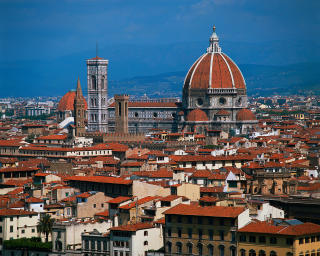
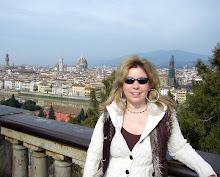
No comments:
Post a Comment